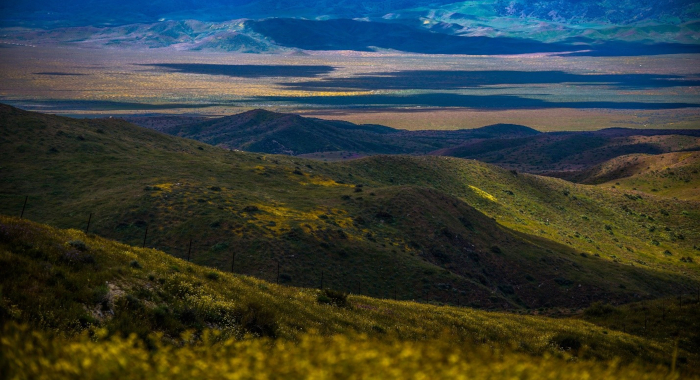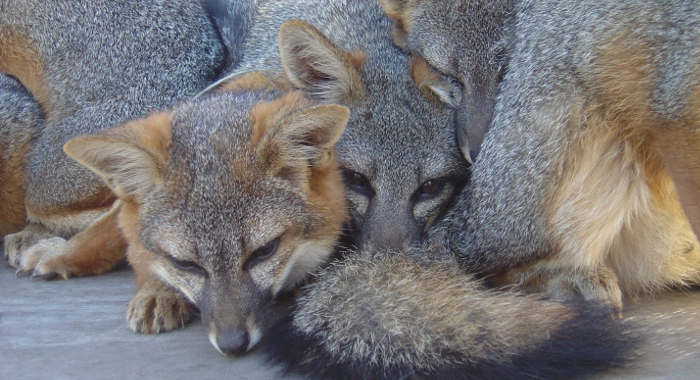Nearly half of California is protected in some land status that prevents most kinds of intensive human land uses. These lands support extensive natural habitats, and for many species, are a critical stronghold in an increasingly human-dominated world.
Yet, changes in the landscape in and near these places have left many in a degraded and precarious condition. Catastrophic wildfire, invasive species, and climate change threaten vast swathes of the state. Protected lands are becoming increasingly isolated by urban and agricultural development, roads, and other infrastructure. Such obstacles can limit a species’ ability to move to across the landscape and adapt to climate change.
Conservancy scientists are working to enhance the resiliency of protected lands in the face of rapid change, and to maintain the landscape connections necessary for plants and animals to adapt over time.


M.B. Pesendorfer, T.S. Sillett, W.D. Koenig, S.A. Morrison
Many corvids are renowned as “ecosystem engineers” because they facilitate the long-distance seed dispersal of keystone tree species like oaks. This paper reviews research into various…Buchalski, M.R, B.N. Sacks, D.A. Gille, M.C.T. Penedo, H.B. Ernest, S.A. Morrison, W.M. Boyce
Bighorn sheep occupy a desert landscape of rugged mountains separated by expansive and very arid valleys. Highways and other development in those valleys fragment habitat and isolate populations from…Morrison, S.A., A.J. DeNicola, K. Walker, D. Dewey, L. Laughrin, R. Wolstenholme, N. Macdonald
This paper describes a program to eradicate an introduced and rapidly increasing population of wild turkeys from an island. It includes a description of the principles important for eradication…Matthew G. Johnson, Kylene Lang, Paul Manos, Greg H. Golet, Kristina A. Schierenbeck
When non-native ornamental species spread into wild landscapes they can displace natives that have greater wildlife habitat value. Controlling the spread of a non-native species can be difficult when…Vasilissa V. Derugin, Joseph G. Silveira, Gregory H. Golet, Gretchen LeBuhn
In restoration ecology, understanding how and when species colonize newly created habitat is critically important for assessing progress toward restoration goals. By using camera traps to take a…Langin, K.M., T.S. Sillett , W.C. Funk, S.A. Morrison, M.A. Desrosiers, C.K. Ghalambor
Islands are renowned laboratories for discovery into natural selection. This study looked at “islands” of habitat within a single island and remarkably found that the Island Scrub-Jay…Hofman, C.A., T. C. Rick, M. T. R. Hawkins, W. C. Funk, K. Ralls, C. L. Boser, P. W. Collins, T. J. Coonan, J. L. King, S.A. Morrison, S. D. Newsome, T. S. Sillett, R. C. Fleischer, J. E. Maldonado
Genomics techniques provide powerful means of understanding evolutionary history. This paper examines the evolution of the island fox, which occurs on six of the California Channel Islands. Insights…Katie Andrews, Megan Webb, Robin Cox
This interactive webmap takes a multimedia approach to showcase the Conservancy’s conservation legacy in Marin County, California. Eleven achievements are profiled with photographs and…H.B. Ernest, T.W. Vickers, S.A. Morrison, M.R. Buchalski, W.M. Boyce
Highly fragmented landscapes can pose myriad threats to wide-ranging species like mountain lions. Coastal southern California has long been the focus of research into demographics, genetics, and…Tim Bean, Bob Stafford, Scott Butterfield, Justin Brashares
This paper presents a multi-step approach to estimate the realized and potential distribution of the endangered giant kangaroo rat. The authors estimate the potential distribution by modeling…Beltran, R.S., N. Kreidler, D.H. Van Vuren, S.A. Morrison, E.S. Zavaleta, K. Newton, B.R. Tershy, D.A. Croll
Introduced predators and herbivores can have dramatic ecological effects on island ecosystems; their eradication can produce similarly profound ecological responses. This paper analyzes data from…Rick, T.C, T.S. Sillett, C.K. Ghalambor, C.A. Hofman, K. Ralls, R.S. Anderson, C.L. Boser, T.J. Braje, D.R. Cayan, R.T. Chesser, P.W. Collins, J.M. Erlandson, K.R. Faulkner, R. Fleischer, W.C. Funk, R. Galipeau, A. Huston, J. King, L. Laughrin, J. Maldonado, K. McEachern, D.R. Muhs, S.D. Newsome, L. Reeder-Myers, C. Still, S.A. Morrison
Understanding the deep history of places and resources, and the interplay between natural and cultural histories, can be critical to science-based conservation management. This paper explores the case…Tim Bean, Laura Prugh, Bob Stafford, Scott Butterfield, Mike Westphal, Justin Brashares
In this study, the authors developed a suite of species distribution models (SDMs) for the endangered giant kangaroo rat using the machine-learning method Maxent. They compared these models with three…H.R. Sofaer, T.S. Sillett, K.M. Langin, S.A. Morrison, C.K. Ghalambor
The density of birds in their breeding areas can affect reproductive success in myriad ways – and it is often difficult to distinguish which factors are more influential. For example, areas that…S.A. Morrison, K.A. Parker, P.W. Collins, W.C. Funk, T.S. Sillett
Pest eradication as a means to restore island ecosystems may come too late for populations that have already been driven extinct. Over decades, the California islands have been the focus of numerous…CL Boser, C Hanna, KR Faulkner, C Cory, JM Randall, SA Morrison
Argentine ants are a highly aggressive and impactful non-native species introduced to California and around the world, impacting ecologically sensitive areas, commercial industries and residential…TJ Coonan, V Bakker, B Hudgens, CL Boser, DK Garcelon, SA Morrison
The island fox is a rare carnivore existing on only six California Channel Islands. In the late 1990’s, due to new and excessive golden eagle predation, it was threatened with extinction on the…Jeanne M. Robertson, Kathryn M. Langin, T. Scott Sillett, Scott A. Morrison, Cameron K. Ghalambor, W. Chris Funk
Conservation of biodiversity can be complicated when there are many priority taxa and tradeoffs in management need to be made. This can be especially challenging on islands, where populations with…Mario B. Pesendorfer, Kathryn M. Langin, Brian Cohen, Zachary Principe, Scott A. Morrison, T. Scott Sillett
Acorns are an important food resource for many species that occupy oak habitats. Patterns of acorn abundance across time and space, however, are often difficult to characterize. This paper describes…